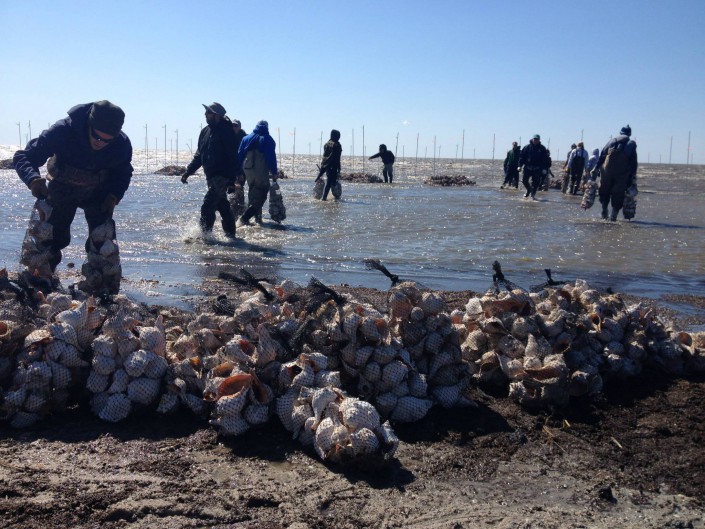Over 130 Volunteers “Shell-a-Brated” Delaware Bay
Oyster Reef Build on South Reeds Beach a Huge Success
By: Lindsay McNamara, Communications Coordinator

Over 130 volunteers and veterans worked alongside Conserve Wildlife Foundation of New Jersey and American Littoral Society to establish a near-shore whelk shell bar at South Reeds Beach in Cape May Court House on the Delaware Bayshore on Saturday, April 4, 2015. The shell bar was built to prevent sand loss from wind-driven waves. During the “Shell-a-Bration,” an approximately 200-foot oyster reef was constructed offshore to test whether the reef bars help reduce beach erosion and create calmer water for spawning horseshoe crabs.
“We are rebuilding the habitats of Delaware Bay to strengthen its ecology, its communities and its economy. This reef approach will be a key technique which we will try to expand around the Bayshore,” stated Tim Dillingham, American Littoral Society Executive Director.
The South Reeds Beach Oyster Reef is one of the many projects that American Littoral Society and Conserve Wildlife Foundation are working on to restore the ecology and economy of the Delaware Bayshore, thanks to generous funding by the National Fish and Wildlife Foundation.
“The project focuses on creating resiliency in Delaware Bay beaches while improving their usefulness to horseshoe crabs. We have a great challenge: how do we create a reef to protect against damaging Bay storms without stopping horseshoe crabs from getting ashore to breed,” said Dr. Larry Niles, a biologist who leads the beach restoration efforts for Conserve Wildlife Foundation of New Jersey and American Littoral Society, and has studied Red Knots for three decades. “This project is an experiment to help us do both,” he added.
Shorebirds, like the federally listed Red Knot, depend on an uninterrupted supply of horseshoe crab eggs when they stopover in Delaware Bay during their migration. In recent years, countless horseshoe crab eggs have been lost because of the devastating storms that swept away the beaches they depend on.
“The time-honored migration of Red Knots to reach the eggs of these ancient horseshoe crabs is a wildlife spectacle of global significance right here in Delaware Bay,” explained David Wheeler, Conserve Wildlife Foundation of New Jersey Executive Director. “Red Knots come to New Jersey’s Delaware Bay from as far away as the southernmost tip of South America to feed on horseshoe crab eggs. It is vital that we promote coastal resiliency projects like this one to support the largest population of horseshoe crabs in the world, and the human communities of the Delaware Bayshore alike.”
The new oyster reef will attenuate waves but still allow for horseshoe crab breeding. In existing areas where crabs can breed without interruption, like creek mouths protected by sand shoals or rock jetties, egg densities can exceed ten times the egg densities on unprotected beaches.
The projects are being funded by National Fish and Wildlife Foundation (NFWF) through their Hurricane Sandy Coastal Resiliency Grants Program, and are being developed in partnership with U.S. Fish and Wildlife Service and New Jersey Division of Fish and Wildlife.
“The Delaware Bayshore is a perfect location to demonstrate how communities benefit from their connection to a healthy natural resource base – for fishing, boating, wildlife watching and tourism,” said David O’Neill, National Fish and Wildlife Foundation Vice President of Conservation Programs. “The economies of Bayshore towns have historically been intertwined with the bay. And with the NFWF Hurricane Sandy grant, American Littoral Society and Conserve Wildlife Foundation of New Jersey are already restoring shorelines to make Bayshore natural resources and communities more resilient for the future.”
Event guests enjoyed a barbecue and oysters, and family-friendly activities like a “Green Eggs in the Sand” Easter Egg Hunt. In addition, local leaders and biologists spoke to the attendees about the oyster reef project at a mid-day “Whelk-come.”
Learn more:
- Conserve Wildlife Foundation’s Delaware Bay Restoration work
- See more photos and a video from the “Shell-a-Bration”
- Latest Headlines: Press Coverage from the “Shell-a-Bration”
Lindsay McNamara is the Communications Coordinator for Conserve Wildlife Foundation of New Jersey.
Discover more from Conserve Wildlife Foundation of NJ
Subscribe to get the latest posts sent to your email.